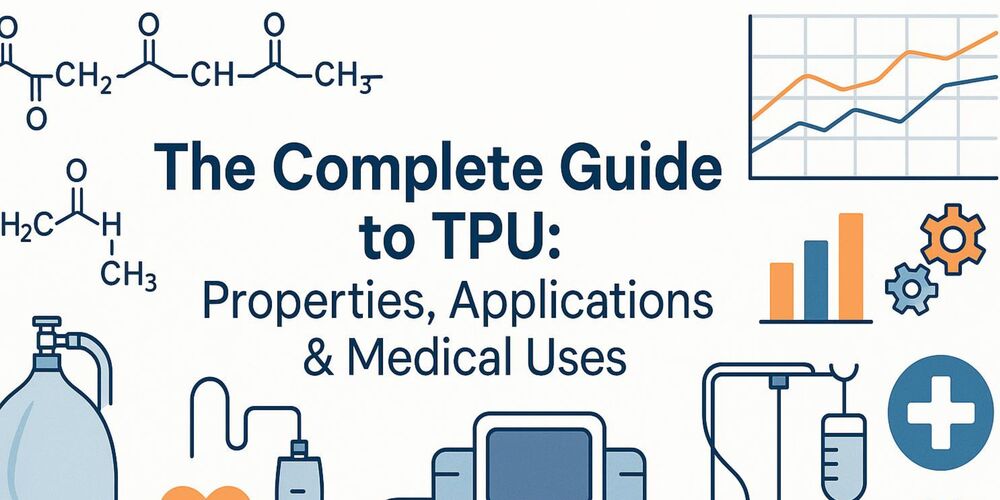Thermoplastic Polyurethane (TPU) Explained
LISTEN TO THIS ARTICLE
Let’s take a closer look at Thermoplastic Polyurethane (TPU) – what it is, why it matters, and how it improves the safety and performance of our Oxygen Reservoir Bags.
What is TPU?
TPU stands for Thermoplastic Polyurethane. TPU is a highly versatile plastic material that bridges the gap between rubber and traditional plastic. This means TPU can become soft and moldable when heated, yet remains durable and flexible like rubber at room temperature.
It’s widely used in everything from sports equipment and mobile phone cases to automobiles and medical devices. Its unique molecular structure gives it a rare combination of flexibility, strength, and chemical resistance.
Key Properties of TPU
-
Elasticity & Strength : High tensile strength with excellent elasticity and rebound
Environmental Resistance : Resistant to oil, water, cold temperatures, and microbial growth - Durability : Superior abrasion, impact, and wear resistance
-
Sustainability : Environmentally friendly with recyclable formulations
TPU Technical Specifications
Molecular Structure
TPU is a linear segmented block copolymer composed of alternating soft and hard segments. These segments are the reason behind TPU’s unique balance of flexibility and strength.
Basic Composition
- Soft segment (based on polyol & MDI) : Provides flexibility and elasticity
- Hard segment (isocyanate + chain extender) : Provides strength and abrasion resistance
Manufacturing Process
- Polymerization : Reaction of diisocyanates (MDI/TDI) with macromolecular polyols and chain extenders
-
Processing : Injection molding, extrusion, or blow molding at 180-220°C
Key Raw Materials
- Polyols : Long, flexible chains of molecules. Polyols give TPU its softness and flexibility. The most common ones are polyester polyols and polyether polyols.
-
Diisocyanates : Reactive chemicals that help link the other parts together. These give TPU its strength and durability. The main types are aromatic diisocyanates (MDI) and aliphatic diisocyanates (like H12 MDI or HDI).
Performance Specifications
| Feature | Specification |
|---|---|
| Tensile Strength | 20-70Mpa |
| Elongation at Peak | 300-800% |
| Shore A Hardness | 70-98 |
| Operating Temperature | -40°C to 80°C |
| Density | 1.10-1.25 g/cm³ |
| Oxygen Permeability | Low (good barrier; suitable for gas barriers) |
Introducing Medical-Grade TPU
Medical-grade TPU is specially formulated to meet strict health and safety standards. While it retains all the mechanical benefits of regular TPU, it undergoes additional testing and quality control to ensure it’s non-toxic, biocompatible, and safe for repeated contact with the human body and medical gases.
What Sets Medical-Grade TPU Apart
- Biocompatibility : Medical-grade TPU has passed strict biological tests, indicating it does not cause adverse tissue reactions and is generally safe for use in the human body.
-
Flexibility and Comfort : Tubes, catheters, and other devices made from TPU can be so soft and comfortable, often replacing PVC that needs added (sometimes toxic) plasticizers.
-
Durability and Long-Term Stability : Retains performance over multiple uses
Chemical and Microbial Resistance : Medical TPU resists bodily fluids, cleaning agents, and even microbes, making it ideal for devices used in demanding, hygienic settings. -
Sterilizability : TPU can withstand standard sterilization methods like ethylene oxide and gamma radiation, ensuring safe and reusable device manufacturing.
Medical Grade Standards
| Standard | Features |
|---|---|
| ISO 10993 |
Evaluates the biological safety of medical device materials. Assesses whether TPU will cause any harm if it contacts skin, blood, tissue, or is used internally. |
| USP Class VI | Involves a series of tests to confirm that the material is non-toxic, non-irritating, and doesn't cause allergic reactions. |
| FDA 21 CFR | Outlines regulations on allowable chemicals in plastics used in medical devices and food contact. |
Common TPU Medical Applications

Why We Use Medical-Grade TPU in Our Oxygen Reservoir Bags
We get it—when you’re inhaling higher concentrations of oxygen while engaging in EWOT sessions, you want assurance that the system won’t compromise your health or oxygen purity. That’s why our Oxygen Reservoir Bags are made from 100% medical-grade TPU.
Here’s what that means for you:
- Oxygen Compatibility : TPU doesn’t react with oxygen or degrade over time. It helps keep your oxygen pure and free from contaminants.
- Leak-Proof Durability : Our Oxygen Reservoir Bags are designed to withstand repeated inflation and deflation without tearing, cracking, or leaking.
- Flexibility : Maintains shape while allowing expansion and contraction during oxygen collection and delivery.
- Safe and Non-Toxic : No plasticizers. No BPA. No phthalates. Just clean, medical-grade material that won’t leach harmful chemicals into your air supply.
-
Reusable : Medical-grade TPU can be safely reused.
Final Thoughts
Now that you know, the material your Oxygen Reservoir Bag is made from really matters.
With medical-grade TPU, you get an Oxygen Reservoir Bag that’s:
- Safe for long-term use
- Resistance to wear and chemical degradation
- Built to preserve the purity and quality of oxygen
That’s exactly why we’ve chosen medical-grade TPU for our reservoir bags. It’s our commitment to your safety and performance.




